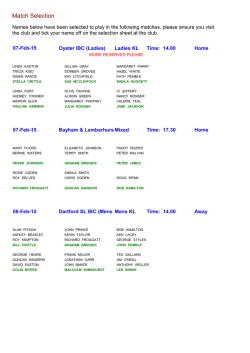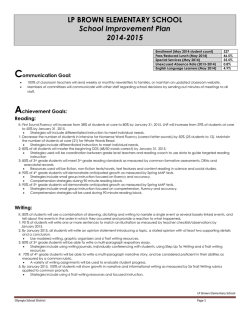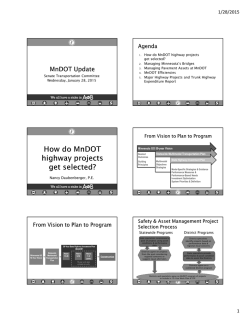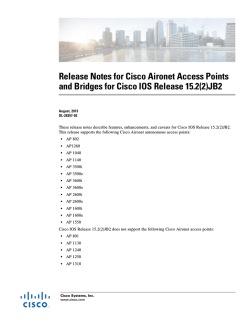
PPT Version
Rbridges: Transparent Routing Radia Perlman [email protected] Goals • Glue a bunch of links together to appear to be a single LAN to IP nodes • No configuration of internal switches • Compatible with existing bridges • Compatible with existing IP nodes (v4 and v6, endnodes and routers) What’s wrong with bridges? • They solve the problems on the previous slide • But: – Routes not optimal – Temporary loops a disaster – Choice of meltdowns or conservative failover Basic idea of transparent bridge • Listen promiscuously • Learn location of source address based on source address in packet and port from which packet received • Forward based on learned location of destination • When in doubt, forward Station learning Q V V A A X,F X X,A,V C F F G But loops are a disaster • No hop count • Exponential proliferation B1 B2 B3 Thus the Spanning Tree Algorithm I think that I shall never see A graph more lovely than a tree. A tree whose crucial property Is loop-free connectivity. A tree which must be sure to span So packets can reach every LAN. First the Root must be selected By ID it is elected. Least cost paths from Root are traced In the tree these paths are placed. A mesh is made by folks like me. Then bridges find a spanning tree. Path from a to c a 2,1,6 2,3,3 11 2,3,3 3 6 c 7 2,2,7 9 2,2,4 2,0,2 2 10 5 2,0,2 4 14 2,2,4 2,1,5 2,1,14 Problems with Bridges • Routes are not optimal (spanning tree) – STA cuts off redundant paths – If A and B are on opposite side of path, they have to take long detour path • Temporary loops really dangerous – no hop count in header – proliferation of copies during loops – So, should be conservative in transition Compare this to routing • • • • • Routers have temporary loops, too Part of the life of distributed algorithms But IP has a hop count (TTL) An IP router only forwards in one direction And the router specifies the next recipient Why bridges are slow to start forwarding • Temporary loops might cause meltdown • Can’t (except in certain special cases, like a port to an endnode) know if turning on a link might cause temporary loop • Simple solution: wait before turning on link, so other bridges can turn off links first • People want instant failover (but they don’t want meltdowns) Bridge meltdowns • They do occur (a Boston hospital) • Lack of receipt of spanning tree msgs tells bridge to turn on link • So if too much traffic causes spanning tree messages to get lost… – loops – exponential proliferation of looping packets Why are there still bridges? • Why not just use routers? – Bridges plug-and-play – Endnode addresses can be per-campus • IP routes to links, not endnodes – So IP addresses are per-link – Need to configure routers – Need to change IP address if change links Using bridges with IP • Bridging is used to create a campus in which all nodes share the same prefix • Looks to IP like a single link • But bridging isn’t as good as routing – – – – Suboptimal routes Traffic concentration (onto spanning tree links) Meltdowns Slow failover What we’d like: best of both worlds • Keep transparency to endnodes and zero configuration • Optimal paths • Make temporary loops safe – Fast failover – No meltdowns Rbridges • Compatible with today’s bridges and routers • Like routers, terminate bridged LAN • Like bridges, glue LANs together to create one IP subnet (or for other protocols, a broadcast domain) • Like routers, optimal paths, fast convergence, no meltdowns • Like bridges, plug-and-play Basic Rbridge idea • Link state protocol among Rbridges (so know how to route to other Rbridges) • “Somehow” learn location of endnodes (e.g., from data traffic, or ARP replies) • Report attached endnodes in link state info • Need to encapsulate pkts – To distinguish originating traffic from transit – To specify next recipient – To include a hop count Rbridging R7 R9 R1 R8 c R5 R4 R3 R6 a R2 Encapsulation Header S=Xmitting Rbridge D=Rcving Rbridge pt=“transit” hop count original pkt (including L2 hdr) • Outer L2 hdr must not confuse bridges • So it’s just like it would be if the Rbridges were routers • Need special layer 2 destination address • for unknown or multicast layer 2 destinations • can be L2 multicast, or any L2 address provided it never gets used as a source address Need spanning tree for flooding • Need it for distributed ARP request • Or for unknown layer 2 destinations (e.g., endnode knows the layer 2 address of the exit router) • Don’t need to use the bridge spanning tree • Instead, compute it from the link state database Rbridges and Bridges R4 R2 R7 Seems like: R2 Actually can be: bridged LAN R4 R7 Example: IP nodes A and B B RB2 RB1 A Example: A and B, Rbridges don’t know B • A issues ARP request for B • RB1 doesn’t know, so issues distributed ARP request (flooded through spanning tree) • Each Designated RBridge issues ARP request on its LAN • RB2 receives a reply (B,b) • RB2 reports (B,b) in its link state info Example: A and B, RBridges DO know B • • • • • A issues ARP request for “B” RB1 responds with an ARP reply (B=b) A transmits to “b” RB1 encapsulates RBridges forward towards “b”, replacing outer header on each hop, and decrementing outer hdr TTL • RB2 decapsulates Example: A and off-campus B R RB2 RB1 A B A and off-campus B • A will send to a router’s layer 2 address, say R’s layer 2 address = x • RBridges have to send to that IP router • If x is in the forwarding table, then RB1 encapsulates and forwards to x • Else (x unknown), RB1 encapsulates and sends on spanning tree • Each Designated RBridge decapsulates Learning a layer 2 address • Can learn from data packets • Or if don’t want to for IP, listen to routing messages in order to learn layer 2 addresses of IP routers Another optimization for IP • Can have short endnode cache timer • Designated RBridge pings to make sure local IP nodes still there Conclusions • Looks to routers like a bridge – invisible, plug-and-play • Looks to bridges like routers – terminates spanning tree, broadcast domain Conclusions, cont’d • Much better replacement for bridging – – – – optimal paths still plug and play and transparent fast convergence no meltdowns • For IP – allows plug-and-play single-prefix campus
© Copyright 2025





